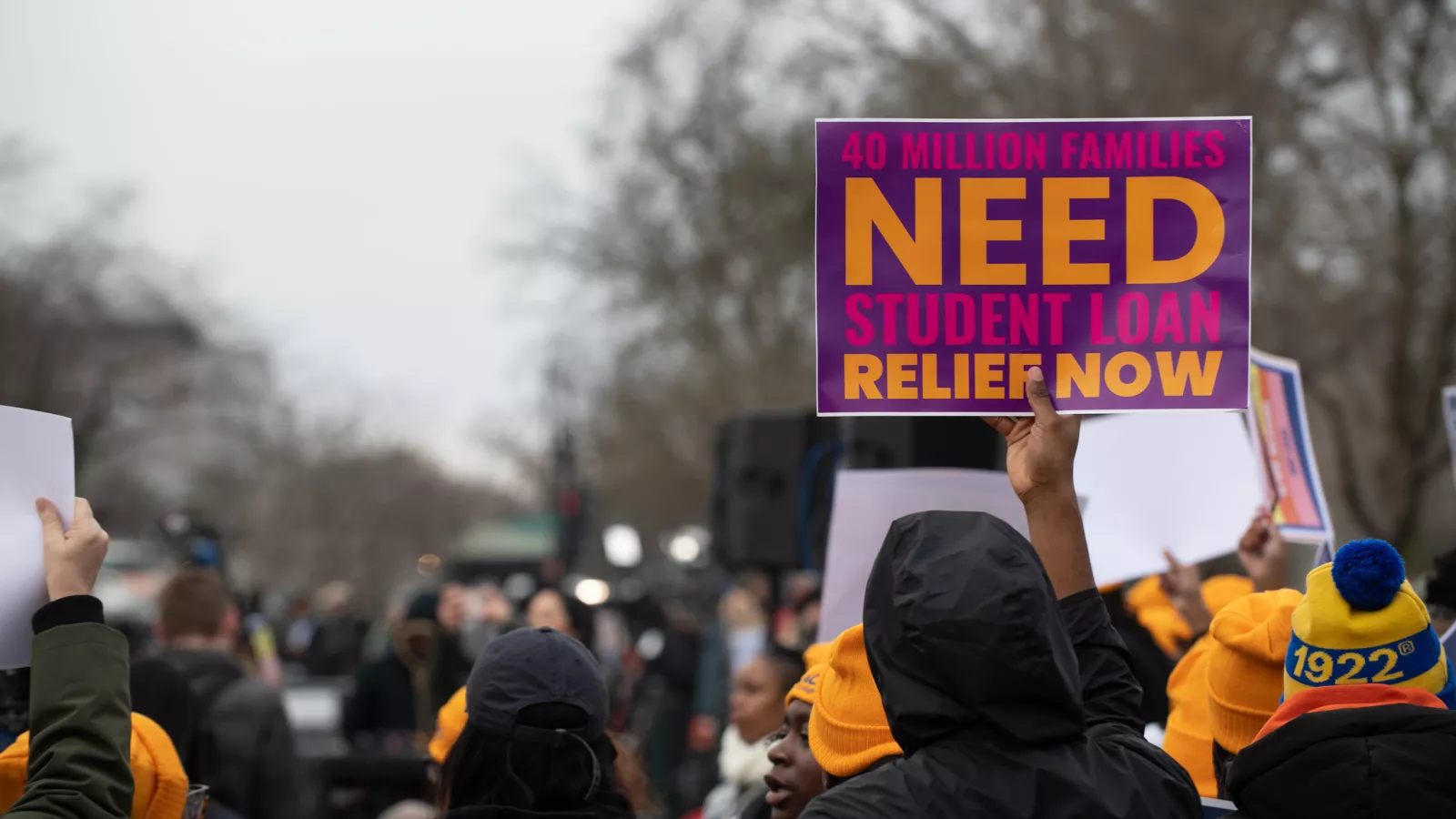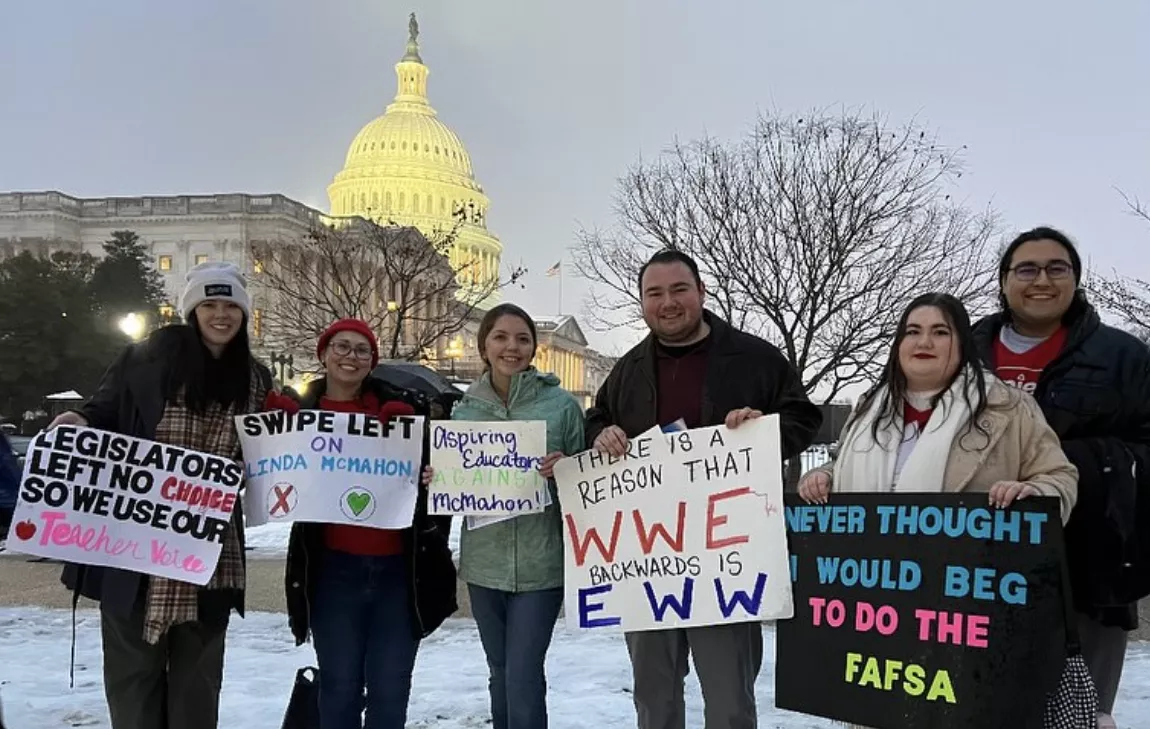How to use this toolkit
- Learn about student debt and options for cancellation and relief.
- Share our conversation starters to help potential and existing members understand NEA's student debt supports.
- Use prompts to schedule follow up conversations that deepen relationships and connections.
Understanding Student Debt
Almost half of all current educators have had to take on student debt to enter the profession. This reality keeps too many talented young people out of the profession and pushes out those who do enter it.
Fixing the student debt crisis makes our public schools stronger.
For years, NEA members have advocated together in favor of cancelling college debt to help fix the educator shortage. Now, because of the Biden administration’s life-changing actions, the student loans taken out by 43 million borrowers are being substantially reduced, forgiven, or even cancelled outright.
The victories around Public Service Loan Forgiveness and student debt cancellation is an excellent example of the power of our union and how educators uniting together can benefit the lives of many.
Our conversation guide
Keep in mind these quick tips when talking about student debt:
- Do think about your own student debt experience and don’t be afraid to share those details with your colleagues. Often, we think of student debt as shameful. It’s not. The fact is the majority of educators couldn’t have become educators without borrowing to pay for college.
- Do emphasize the positive. NEA’s resources are working for educators with debt! Many, many educators are navigating the road to student debt forgiveness.
- Don’t memorize a list of facts and use it in conversation. The best conversations involve authentic engaging and listening—not rote recitation.
Listening well is key to any organizing conversation. Below are some helpful tips and tricks to being the best listener.
Listening Do's:
- Listen 80 percent of the time; talk 20 percent of the time.
- Ask follow-up questions using how, what and why.
- Practice empathy. Talking about student debt can be emotional. Educators might share that their debt keeps them up at night! Acknowledge and respect their experiences.
- Give the other person time to think about and answer your questions.
- Localize the conversation by talking about colleagues in your community or state who have received debt forgiveness, or personalize it by talking about your own experience.
Listening Don'ts:
- Don’t ask questions that are statements. For example, “Wouldn’t it be better if colleges were less expensive?”
- Don’t answer a question if you don’t know the answer! It’s okay to tell somebody, I don’t know the answer to your question, but I’ll find out and get back to you.
- Don't make the union the focus of your conversation. Your conversation should be focused on the needs and experience of the person you’re talking with.
These messages can serve as the backbone to your conversation on student debt and union membership:
- Higher education must be affordable and accessible to all. Yet, for too many, pursuing our college and career dreams means years, even decades of paying off student debt. This is especially true for educators. This system is working for the student loan providers and banks, but not for us.
- Policymakers have slashed public investment in higher education, offloading the skyrocketing costs onto students. They keep us divided by race and class so that they can make backroom deals with banks and loan servicers.
- Young or old, Black or white, educators of all ages and races have had to take on student debt to enter the profession. This reality keeps too many talented young people out of the profession and pushes out those who do enter it. Generations of barriers also have denied Black, brown, and Indigenous communities a fair shot at resources that would make the college dream a reality.
- With this crisis, however, comes the opportunity to create a better, more just system. We can create a world without student debt. A world where every student, educator, parent, and friend can dream without limits. Where a higher education only means greater possibilities.
- Because of the educators and allies who took action, the Biden Administration is working on providing broad student debt relief for as many working and middle-class borrowers as possible. His student debt relief plan builds on the progress of the temporary Public Service Loan Forgiveness waiver, which has delivered $47 billion in loan forgiveness for 670,000 public-service workers and counting.
- But we won't stop until everyone is able to learn and grow without a lifelong burden of student debt. With more members, we have more power to create change. Join the National Education Association to access vital student debt support and to add your voice to the movement to make higher education affordable for everyone.
- NEA has a lot of resources to help educators manage their debt. For new educators, this means getting on a monthly payment plan that is 1) affordable; and 2) on track for Public Service Loan Forgiveness (PSLF). For educators with more experience, it means making sure they know about the new PSLF waiver.
- These resources are effective! They are helping thousands of educators of all ages and all races, including college and university faculty and education support professionals from pre-K-16, to finally get free of their college debt burden.
I heard the student debt system is broken. Why would I waste my time on applying for relief?
- Affirm: Yes, you heard right. It used to be nearly impossible to get student debt relief.
- Answer: A lot of improvements have been made since President Biden took office. For example, after NEA members sent 48,000 emails to the Department of Education, the Education Secretary created a temporary waiver expanding the kinds of payments that count toward Public Service Loan Forgiveness (PSLF). Many of these changes have been maintained beyond the expiration of the waiver, and hundreds of thousands of public service workers have gotten their student debt cancelled through PSLF in the past few years.
- Redirect: NEA has expert-curated resources designed to help you get relief. Find them at nea.org/mystudentdebt.
It’s just too complicated. I don’t even know where to start.
- Affirm: Yes, it does feel complicated. All these acronyms—PSLF, TLF, etc., and then the different kinds of loans, payment plans, forgiveness programs. The system was designed this way by loan servicers to try to keep people from relief.
- Answer: It’s confusing, but it’s not impossible to figure out. And there is support to help you through every step of the process.
- Redirect: NEA has resources that can help, including student debt experts who will talk to NEA members on the phone for free—and even file the PSLF paperwork. NEA members can access this help through the NEA Student Debt Navigator. Not a member? You can text STUDENTDEBT to 48744 to get other student debt resources.
I think some of these student loan forgiveness programs are unfair. How is it right that some people have to pay their college debts and others don’t?
- Affirm: Yes, I hear you. The system does seem to benefit some and not all.
- Answer: The student debt system is broken. The cost of higher education has skyrocketed while more and more jobs are requiring degrees and certifications. Many people have seen their wages depressed, whether because they choose public service or because of historic inequalities around race and class. We need to fix the problem through programs that make higher education more affordable and repayment more manageable. In the meantime, we must help the millions of Americans who took out student loans under our current system. Fixing this crisis may directly benefit certain people over others, but it makes our education system and our communities stronger for everyone.
- Redirect: When we work together we can create the change our public schools need. Becoming a part of your union allows your voice to be heard at the table where these decisions are made. Can I talk to you more about membership?
Student debt is kind of red herring, right? We really should be talking about the price of college or why nobody wants to be an educator anymore...
- Affirm: Yes! These are really important issues!
- Answer: Student debt forgiveness is really important to people who have already had to borrow to pay for college. We’re doing what we can to help those people, even while we work on other big issues, like the lack of state funding for higher education.
- Redirect: Everybody has a voice. If you want to get involved in the fight to end corporate tax breaks and restore public funds for public schools and colleges, check out the NEA Action Center.
Use this email prompts to start a conversation with someone following an initial contact. You can also change the language a bit and use it to reach out to someone you haven't heard from in a while!
---
Hi <FIRSTNAME>,
It’s <YOURNAME> from <AFFILIATENAME>! It was great meeting you at <EVENTNAME>.
Everyone—no matter where they are from or how much is in their bank account—deserves to learn and grow without limits. That’s why tens of thousands of educators took action over the past few months to make sure our higher education system works for students, not for bankers and their profits.
10 years of public service equals no student debt. That is the promise. And we will not stop until that promise is kept to everyone. Take these three steps to ensure you get the support you deserve:
- Begin your application for Public Service Loan Forgiveness
- Get free 1:1 support from the NEA Student Debt Navigator (Not a member of NEA, join today to get this benefit!)
Our victories around student debt show the power educators can have when we come together. But we still have more to accomplish. I’d love to chat with you about our union’s work. Do you have time in the next few weeks?
In solidarity,
<YOUR NAME>
P.S. Pass it on! Share these resources with a friend or colleague.
Hi <FIRSTNAME>, It’s <YOURNAME> from <AFFILIATENAME>! It was great meeting you at <EVENTNAME>. NEA has student debt support designed to connect educators with expert advice and relief. Are you interested in learning more?
Understand NEA's Student Debt Support
Navigate Your Student Debt
Get Public Service Loan Forgiveness
The SAVE Plan
Meet the NEA Student Debt Navigator
Expert Webinars
Almost half of all current educators have had to take on student debt to enter the profession. This reality keeps too many talented young people out of the profession and pushes out those who do enter it.
We believe that every educator should be able to afford to learn without limits, and without a lifelong burden of student debt. That's why NEA’s student debt experts have created tools designed to help educators through the complicated student debt system, including webinars explaining opportunities for relief.
Find past webinar recordings here:
Share Online
Social Media Messages
In the last year, educators have gotten over $1 million dollars in student debt cancellation. Learn how: <LINK>
10 years of public service equals no student debt. Congress made that promise to educators in 2007. And we will not stop until that promise is kept to everyone. Check out the link in bio to find the tools you need to #CancelStudentDebt.
Link for Instagram bio: <LINK>
Hundreds of thousands of public service workers have gotten student debt relief through Public Service Loan Forgiveness. What this means for you: <LINK> #CancelStudentDebt
Student Debt Graphics
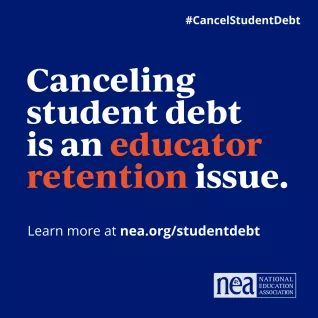

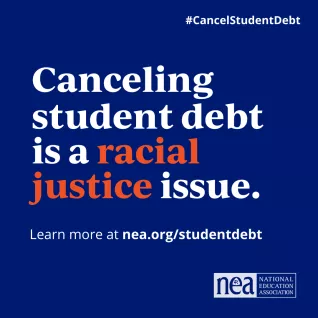

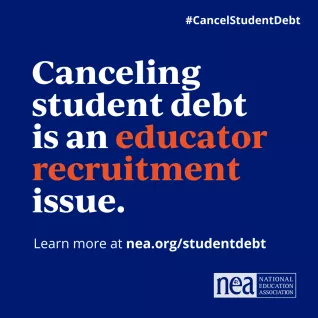

MORE WAYS TO TALK ABOUT YOUR UNION

How to Have Transformational Organizing Conversations
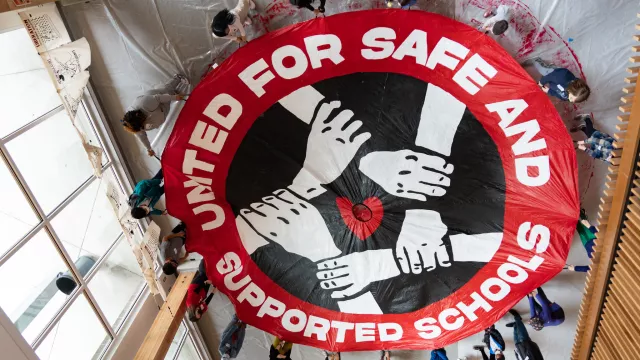
Let's Talk About Union Membership
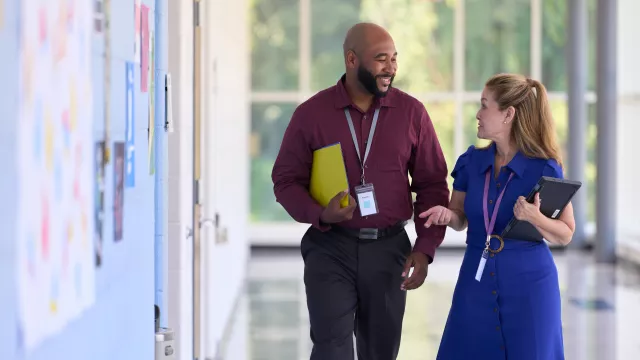
Organizing Conversation Starters
Join Our Movement

